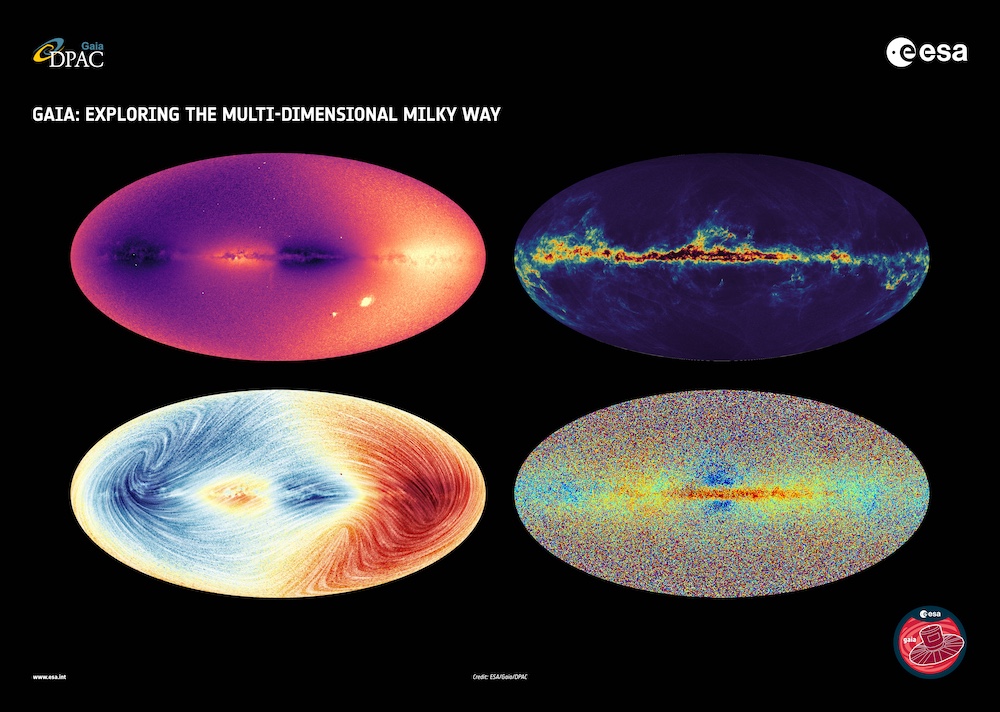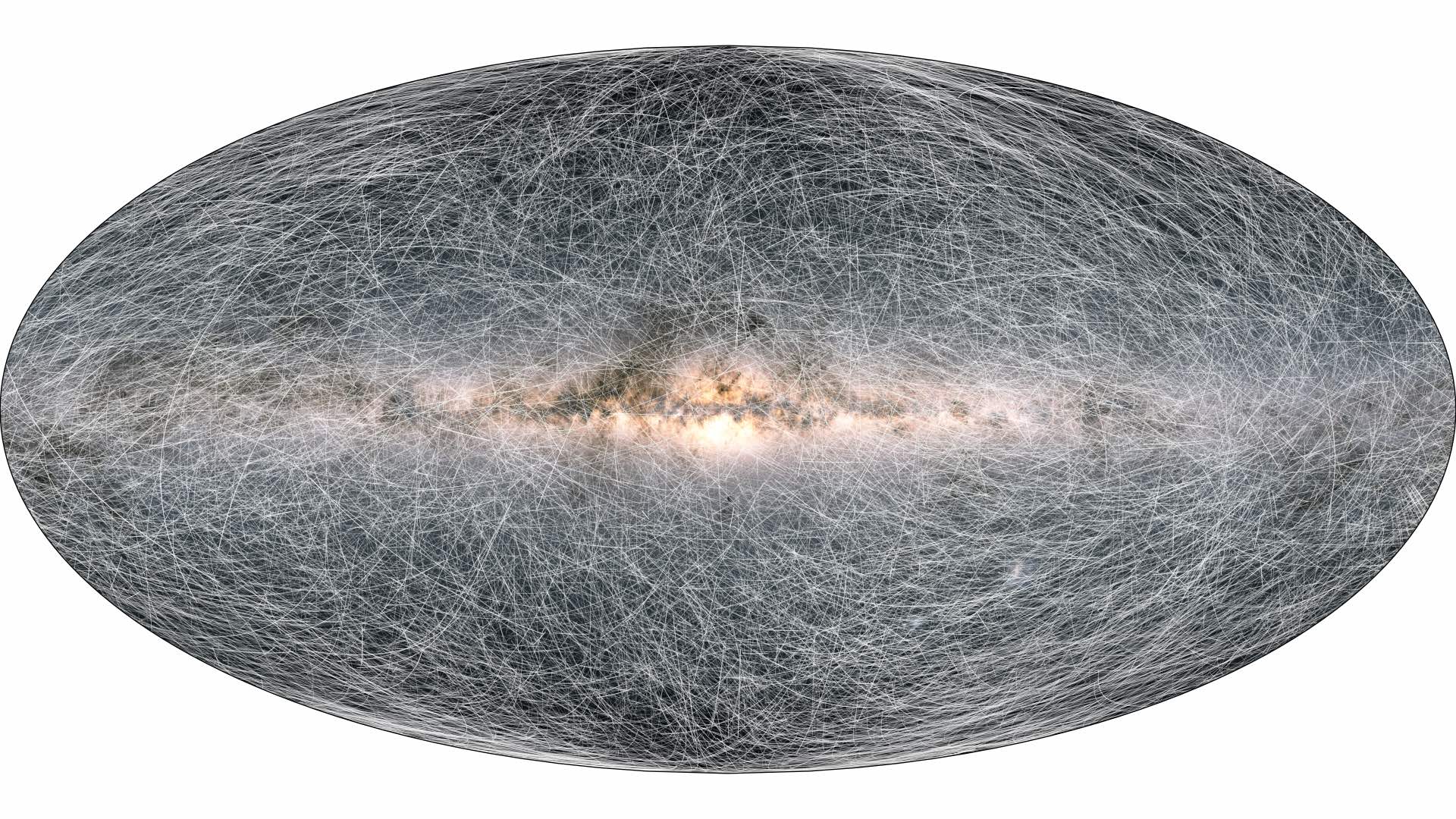Highlights of Gaia DR3 - Gaia
Science highlights of Gaia DR3
Credit: ESA/Gaia/DPAC, CC BY-SA 3.0 IGO
Selection of stories related to Gaia's Data Release 3 published on ESA websites
23/07/2024: How binary stars change their stellar dance with age
25/06/2024: Dynamical masses across the Hertzsprung-Russell diagram
20/06/2024: Scientists spot hidden companions of bright stars
06/06/2024: Gaia: Milky Way's last major collision was surprisingly recent
28/05/2024: Did Gaia find its first neutron star?
22/04/2024: Sailing among the stars - Gaia's role in discovering distant worlds
22/04/2024: Gaia's contribution to discovering distant worlds
02/04/2024: The Gaia Cataclysmic Variable hook
18/03/2024: Gaia maps largest ever collection of quasars in space and time
19/12/2023: Gaia's decade of discoveries: unravelling the intricacies of our galaxy
19/12/2023: 10 Science topics to celebrate Gaia's 10 years in space
- Stellar occultation
- Asteroids and moons
- Spiral arms and structure
- Stellar companions
- Special stars
- Stellar DNA
- 3D motion
- Milky Way satellites
- Gaia's galaxies
- Cosmology with Gaia
31/10/2023: Gaia observes cosmic clock inside a heavenly jewel
27/09/2023: Does the Milky Way contain less dark matter than previously thought?
22/09/2023: Mass-luminosity relation from Gaia's binary stars
13/06/2023: Gaia's multi-dimensional Milky Way
23/05/2023: Has Gaia found missing link in black hole evolution?
18/05/2023: Mapping the Milky Way
13/04/2023: Wobbling star found in Gaia-Hipparcos data confirmed to host exoplanet
05/04/2023: Dual quasar found to be hosted by an ongoing galaxy merger at redshift 2.17
30/03/2023: Gaia discovers a new family of black holes
31/01/2023: Gaia reaches to the clouds – 3D kinematics of the LMC
25/01/2023: Meet your neighbours: CNS5 - the fifth catalogue of nearby stars
04/11/2022: Gaia's first black hole discovery: Gaia BH1
20/10/2022: Shadow hunters capture Didymos asteroid eclipsing stars
26/10/2022: Are Newton and Einstein in error after all?
12/10/2022: 30,000 near-Earth asteroids discovered and rising
06/10/2022: Mapping the interstellar medium using the Gaia RVS spectra
11/08/2022 Gaia reveals the past and future of the Sun
13/06/2022 Gaia Data Release 3 - in-depth stories
- What are the stars made of? - A chemical map with Gaia DR3
- Do they move away? - The Gaia DR3 radial velocities bringing the third velocity component
- What is in between the stars? - Gaia's view on dust and the interstellar medium
- How did dpac produce the data? - insight in pipelines, calibrations and organisation of Gaia DPAC
- Is it a double star? - Discover Gaia's non-single star catalogue
- How big, warm, old, ... are they? - Gaia's stellar parameters
- How do they blink? - The dimming and brightening of Gaia's variable stars
- How bright are the stars? - The Gaia DR3 magnitudes
- Who created the data? - The people behind the scenes
- Is it a quasar? - The Gaia DR3 quasar candidates
- Do they go boom? - Gaia's science alerts
- How far away are they? - The Gaia parallaxes explained
- Is it a solar system object? - The objects in our Solar System seen by Gaia
- What colour do they have? - Gaia's blue and red photometer data in DR3
- Did something move in front? - Gaia's exoplanets and host stars in DR3
- Is it a galaxy? - The galaxies in Gaia DR3
- Can I use Gaia data with other observatories? - Using Gaia's data for follow-up
- Where do they go? - Wavy proper motion patterns and the rotation of the Milky Way disk
- Where are the stars? - Gaia's astrometry highlighted
- Where is the data? - The archives at ESAC and the people behind
13/06/2022 Gaia data release 3 press events
13/06/2022: Image and video releases for Gaia Data Release 3
- Sonification: Gaia sees starquakes
- Animation: the chemistry of our Milky Way
- Animation: the asymmetric Milky Way in motion
- Animation: Gaia data release 3: exploring our multi-dimensional Milky Way
- Animation: Asteroid populations in Gaia data release 3
- Image: Gaia's chemical map of the Milky Way
- Image: Gaia's Milky Way in motion
- Image: Gaia: Exploring the multi-dimensional Milky Way (portrait version)
- Image: Gaia: Exploring the multi-dimensional Milky Way (landscape version)
- Image: You are here
13/06/2022: Press releases for Gaia Data Release 3
10/06/2022: Gaia observes the Milky Way
10/06/2022: Watch live: first impressions of Gaia data release 3
09/06/2022: BP/RP low-resolution spectroscopy across the Hertzsprung-Russell diagram
31/05/2022: Media invitation: new details about our Milky Way in the third Gaia data release
31/05/2022: Gaia data release 3 media kit
- Media kit in English
- Media kit in French
- Media kit in German
- Media kit in Italian
- Media kit in Spanish
- Media kit in Dutch
27/05/2022: Cepheids and their radial velocity curves
23/05/2022: The Galaxy in your preferred colours
19/05/2022: GaiaXPy 1.0.0 released, a tool for Gaia's BP/RP spectra users
13/05/2022: Gaia - ESA's billion star surveyor
31/01/2022: Astrometric orbit of the exoplanet-host star HD81040
23/12/2021: Signal-to-Noise ratio for Gaia DR3 BP/RP mean spectra
09/07/2021: How Gaia unveils what stars are made of
27/04/2021: HIP 70674 Orbital solution resulting from Gaia DR3 processing
30/03/2021: First transiting exoplanet by Gaia
22/12/2020: QSO emission lines in low-resolution BP/RP spectra
12/08/2020: First calibrated XP spectra
- Removed a total of (2) style text-align:center;
- Removed a total of (1) style display:none;
Science highlights of Gaia EDR3
Credit: ESA/Gaia/DPAC, CC BY-SA 3.0 IGO
Selection of stories related to Gaia's Early Data Release 3
26/09/2022: Gaia on the hunt for dual quasars and gravitational lenses
23/09/2022: Gaia's observation of relativistic deflection of light close to Jupiter
07/06/2022: Jupiter's moon Europa to obscure distant star
11/05/2022: Systemic proper motions of 73 galaxies in the Local group
17/02/2022: Gaia reveals a new member of the Milky Way family
12/01/2022: The Local Bubble - source of our nearby stars
05/01/2022: A Milky-Way relic of the formation of the Universe
22/12/2021: The 7 October 2021 stellar occultation by the Neptunian system
01/12/2021: Observation of a long-predicted new type of binary star
24/11/2021: Gaia reveals that most Milky Way companion galaxies are newcomers to our corner of space
24/09/2021: Astrometric microlensing effect in the Gaia16aye event
22/09/2021: the power of the third dimension - the discovery of a gigantic cavity in space
26/03/2021: Apophis' Yarkovsky acceleration improved through stellar occultation
03/12/2020: Gaia Early Data Release 3 - press releases
- ESA's press release: "Gaia's new data takes us to the Milky Way's anticentre and beyond" (English)
- Press release by the French contribution in Gaia DPAC (French)
- Press release by the Royal Astronomical Society in the UK (English)
- Press release by University of Warsaw (Polish)
- Press release by DLR (German / English)
- Press release by Eötvös Loránd Research Network (Hungarian)
- Press release by University of Helsinki (English)
03/12/2020: Gaia Early Data Release 3 - release stories for the general public
- Gaia's new data takes us to the Milky Way and beyond
- Video release: Orbits of nearby stars around the galaxy
- Video release: Measuring the acceleration of the Solar System with Gaia
- Video release: Bridge of stars
- Video release: Gaia's stellar motion for the next 1.6 million years
- Image release: Gaia's stellar motion for the next 400 thousand years
- Image release: Gaia's view of the Milky Way's neighbouring galaxies
- Image release: Gaia's early data release 3 in numbers
- Image release: The density of stars from Gaia's early data release 3 - equirectangular projection
- Image release: The density of stars from Gaia's early data release 3
- Image release: The colour of the sky from Gaia's early data release 3 - equirectangular projection
- Image release: The colour of the sky from Gaia's early data release 3
03/12/2020: Gaia Early Data Release 3 - release stories for the scientific community
- Following the journey of stars across the sky
- Gaia DPAC
- The Galactic anticentre
- CU5 - a human story
- The acceleration of the solar system with respect to the distant universe
- A dive into the Magellanic Clouds
- CU3 - a human story
- Gaia Catalogue of Nearby Stars
- Gaia EDR3 versus Gaia DR2
- Questions and Answers
29/10/2020: Gaia EDR3 passbands
09/10/2018: 3rd Gaia DPAC Consortium Meeting
- Removed a total of (1) style text-align:center;
- Removed a total of (1) style text-align:right;








































 Sign in
Sign in
 Science & Technology
Science & Technology

